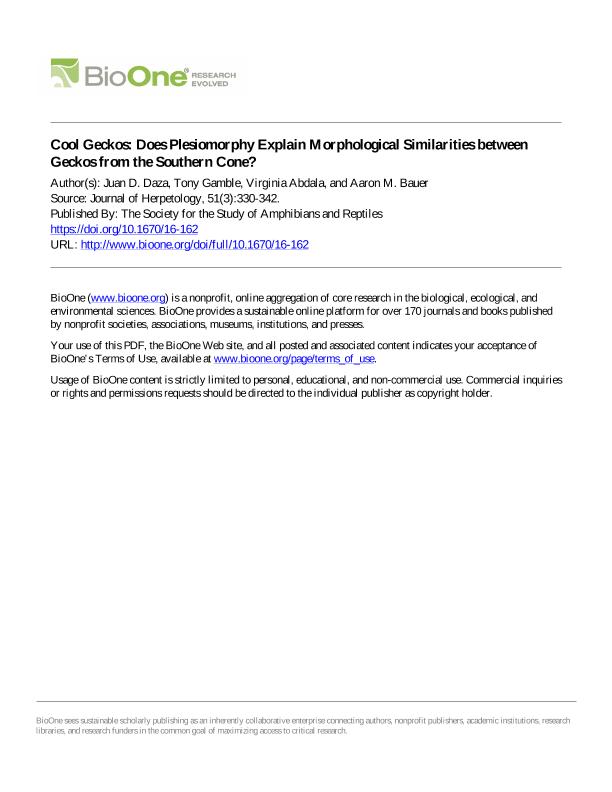Artículo
El género Homonota del sur de América del Sur comprende diez especies de gecos de cabeza ancha, alcanzando el límite austral para los Gekkota. Históricamente, los datos morfológicos han apoyado la monofilia de un grupo que incluye Homonota y el género chileno Garthia, con la posibilidad de que el género anterior estuviese contenido en el primero. Por otro lado, la evidencia molecular reciente indica que éstos dos géneros forman dos clados separados y que Homonota está más cercano a los gecos con dedos en forma de hoja del género Phyllodactylus. En este trabajo, analizamos 592 caracteres morfológicos en Garthia, Homonota, además de otros de la familia Phllodactylidae con el propósito de evaluar las similitudes morfológicas. Nuestros resultados indican que Homonota y Garthia comparten la mayoría de caracteres externos e internos, y que son casi indistinguibles morfológicamente. Estos resultados son interpretados utilizando una filogenia molecular reciente de varios genes, y sugieren que Garthia y Homonota retienen una gran cantidad de simplesiomorfias, las cuales están asociadas a sus hábitos terrestres y a procesos de miniaturización, como también a su diferenciación de los gecos americanos con dedos de hoja. The South American genus Homonota comprises 10 species of Broad-Headed Geckos that reach the austral limit for the Gekkota. Historically, morphological data have supported the monophyly of a group including Homonota and the Chilean genus Garthia, with the latter possibly embedded within the former. In contrast, molecular evidence indicates these two genera to be in separate clades and that Homonota is more closely related to the Leaf-Toed Geckos of the genus Phyllodactylus. Here, we analyze 592 morphological characters in Garthia, Homonota, and additional phyllodactylid geckos to evaluate their morphological similarities. Our results indicate that Homonota and Garthia share a great majority of both external and internal characters and are nearly indistinguishable on morphological grounds. These results are interpreted in the light of a recently published multigene molecular phylogeny, and they suggest the symplesiomorphic retention of many morphological states linked to miniaturization and terrestriality in Garthia and Homonota, and concomitant differentiation of the American Leaf-Toed Geckos.
Cool geckos: Does plesiomorphy explain morphological similarities between geckos from the southern cone?
Fecha de publicación:
09/2017
Editorial:
Society for the Study of Amphibians and Reptiles
Revista:
Journal of Herpetology
ISSN:
0022-1511
Idioma:
Inglés
Tipo de recurso:
Artículo publicado
Clasificación temática:
Resumen
Palabras clave:
Gekkos
,
Phylogeny
,
Homonota
Archivos asociados
Licencia
Identificadores
Colecciones
Articulos(IBN)
Articulos de INSTITUTO DE BIODIVERSIDAD NEOTROPICAL
Articulos de INSTITUTO DE BIODIVERSIDAD NEOTROPICAL
Citación
Daza Vaca, Juan Diego; Gamble, Tony; Abdala, Virginia Sara Luz; Bauer, Aaron M.; Cool geckos: Does plesiomorphy explain morphological similarities between geckos from the southern cone?; Society for the Study of Amphibians and Reptiles; Journal of Herpetology; 51; 3; 9-2017; 330-342
Compartir
Altmétricas




